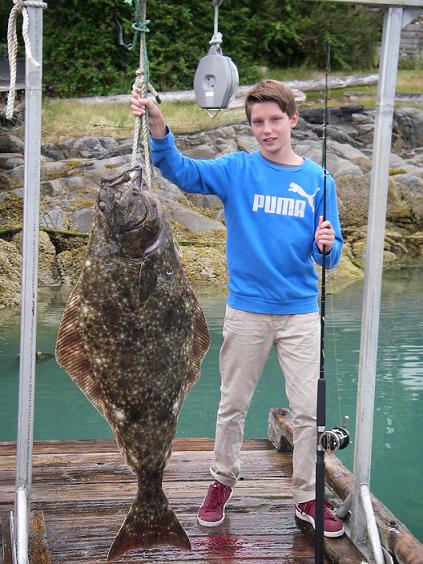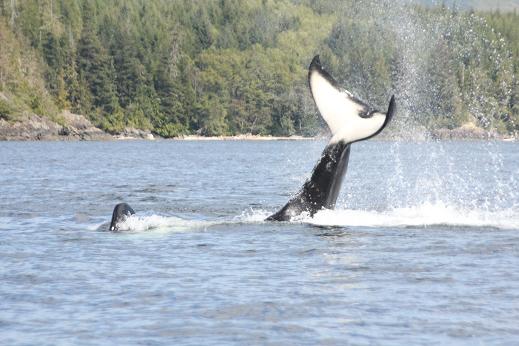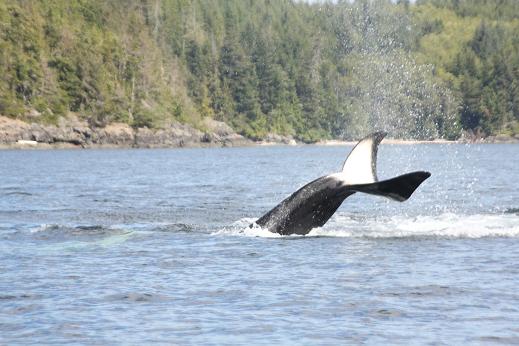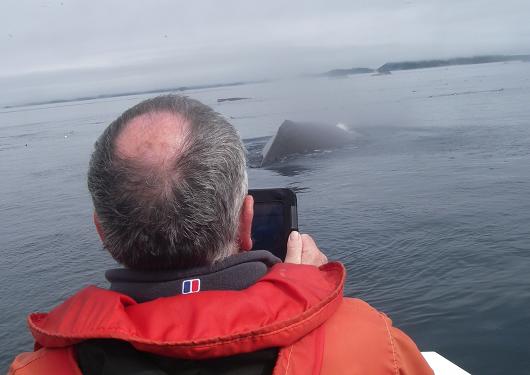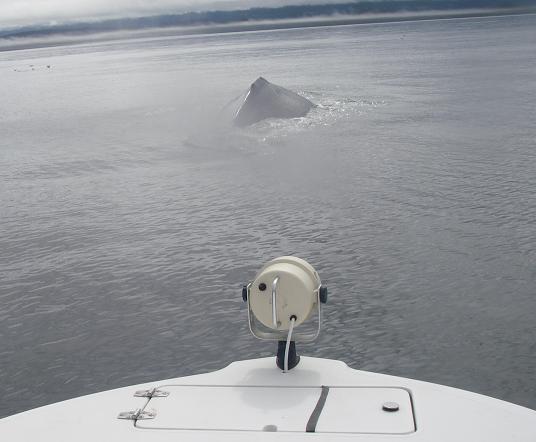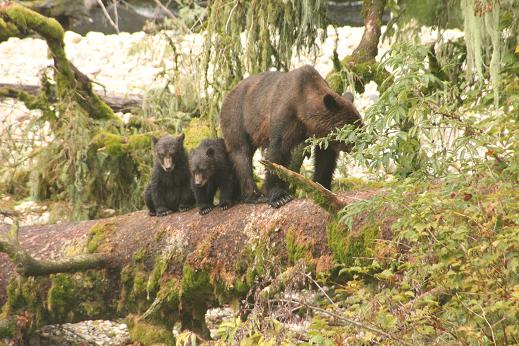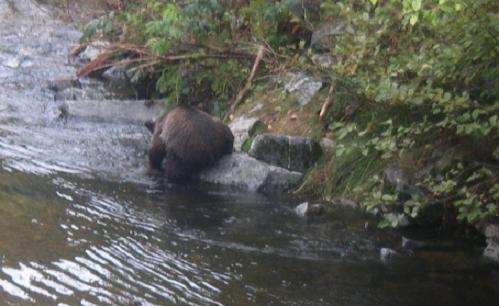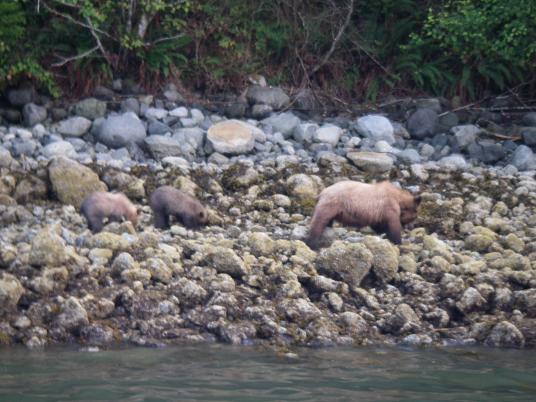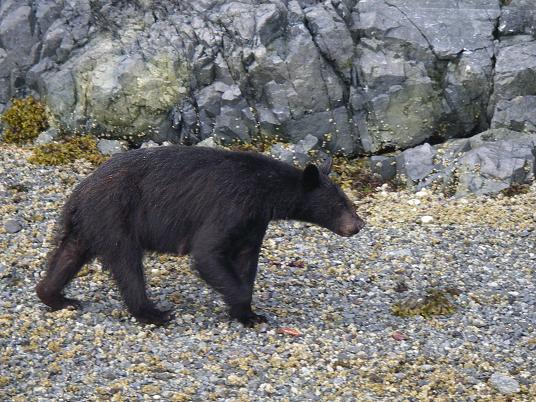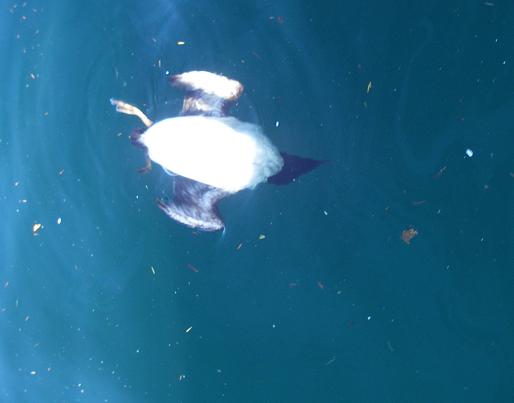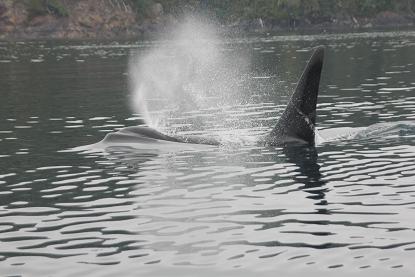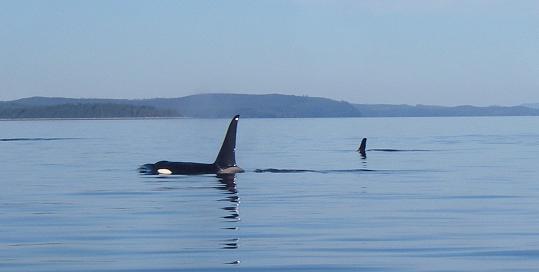Not all guests are this lucky when spending time fishing off the dock at Grizzly Bear Lodge. This is a 30 k (app. 65 lb.) halibut that we were able to bring onto the dock after getting it free of the anchor chains holding the dock in place. Not sure how that happened but it did and with Angus’s help we got it up for a picture. With halibut this would mean about 45 lbs. of meat which also means several dinners at the lodge and many happy guests.
Grizzly Bear and Wildlife Viewing Blog: Yearly Archives: 2016
Killer Whale tail slapping
A killer whale’s inverted Tail Lob – while on its back, it raises its flukes above the water’s surface and brings them down with force. This type of behavior is often viewed when the whales are in close contact with their pod or grouped together with other pods and seems to be a form of communication. Whether tail slapping is a friendly or an aggressive form of behaviour is not proved beyond a doubt but a majority of the times it seems to be a playful thing especially within the Northern Resident Whales that are in our viewing area. The sound that echoes after a tail slap can be very loud.
Humpback whale off bow of boat 2 of 2
They were not paying attention because there were two humpback whales of the stern. And one was closer than the one from the front but I missed the tail again. I did get the photo I wanted one that shows a guest getting a close up of the whale activity we frequently experience on your marine wildlife trips. It in not uncommon to see a dozen or more humpbacks on a day trip from Grizzly Bear Lodge and when we stop for lunch and drift in an area where the whales are feeding it can get very interesting.
Humpback whale off bow of boat 1 of 2
Grizzly bridge over river to salmon?
Yes this is the same mother grizzly bear from yesterday’s post. Most first year cubs prefer to stay dry so would rather walk a log than swim the river. But they are sitting down looking into the river and this is their favourite perch when their mother is fishing. As soon as she catches a salmon they leave the perch and go to mother for their share but some times (see yesterdays post) they are too late.
Backward grizzly bear eating salmon
Most grizzly bears that catch a salmon will take it to shore or at least use a rock as a table to make it easier to eat. This grizzly sitting on the rock and eating the salmon almost in the water seemed to be hiding its catch. It was hiding its catch from one of its cubs. Above the bear to the right you can just see one of her cubs and the fact that she has two means she needs a meal on her own and does not share all her catches.
Evening black bear tour from Grizzly Bear Lodge
Yesterday’s post was a black bear on a whale watching tour while today’s is a grizzly bear on an evening black bear tour. On your first evening in the lodge we go for an hour or so boat ride looking for black bears and other wildlife. I remember this trip as it was the longest evening black bear tour that lasted two and half hours (we did get back before dark but just). We found a mother grizzly and two cubs on the beach and we followed them for over an hour as they slowly made their way along the beach turning over rocks and at time stopping to berries and eat grass above the high tide mark. Our tours do not normally have a tight schedule if we find something interesting we watch.
Black bear on the beach without cub
This black bear mother was spotted on the way to our day’s whale watching tour. It is a good area to find black bears especially if there is a low tide in the morning. This nursing mother (look closely at the photo) was on the beach alone that means she must have left her cub sleeping in the bush the above high water mark. We know she has one cub because we had seen them in this area on the previous day.
Common Murre and Killer Whale Saga
The common murre is a medium-sized waterbird with a black back and head, white underside and a long, slender, pointed bill. Ironically except for the waterbird and bill it also describes an orca / killer whale. On this morning we came upon a lone transient or Biggs orca (they are the mammal eaters). It was odd enough for this orca to be on its own but apparently it travels this way frequently. It was also playing with the murres with unfortunate side effects. It would come up beneath the birds and grab them and then toss them into the air. It would play with them for a while and then find another. It was fascinating to watch but also sad as there were four murres left on the surface.
